Study Skills Report: Learning Styles and Approaches Overview
VerifiedAdded on 2023/01/19
|10
|3473
|88
Report
AI Summary
This report provides a detailed overview of study skills, focusing on different learning styles and approaches relevant to higher education. It explores various learning styles, including visual, aural, verbal, physical, logical, social, and solitary, and discusses the importance of understanding these styles for effective learning. The report also covers different learning approaches such as behaviorist, cognitive, and humanist approaches. Furthermore, it delves into the capabilities of the brain, highlighting the functions of different brain sections and how mind mapping can aid in information storage and retrieval. The report emphasizes the practical application of these concepts to help students enhance their study habits and achieve better academic outcomes.
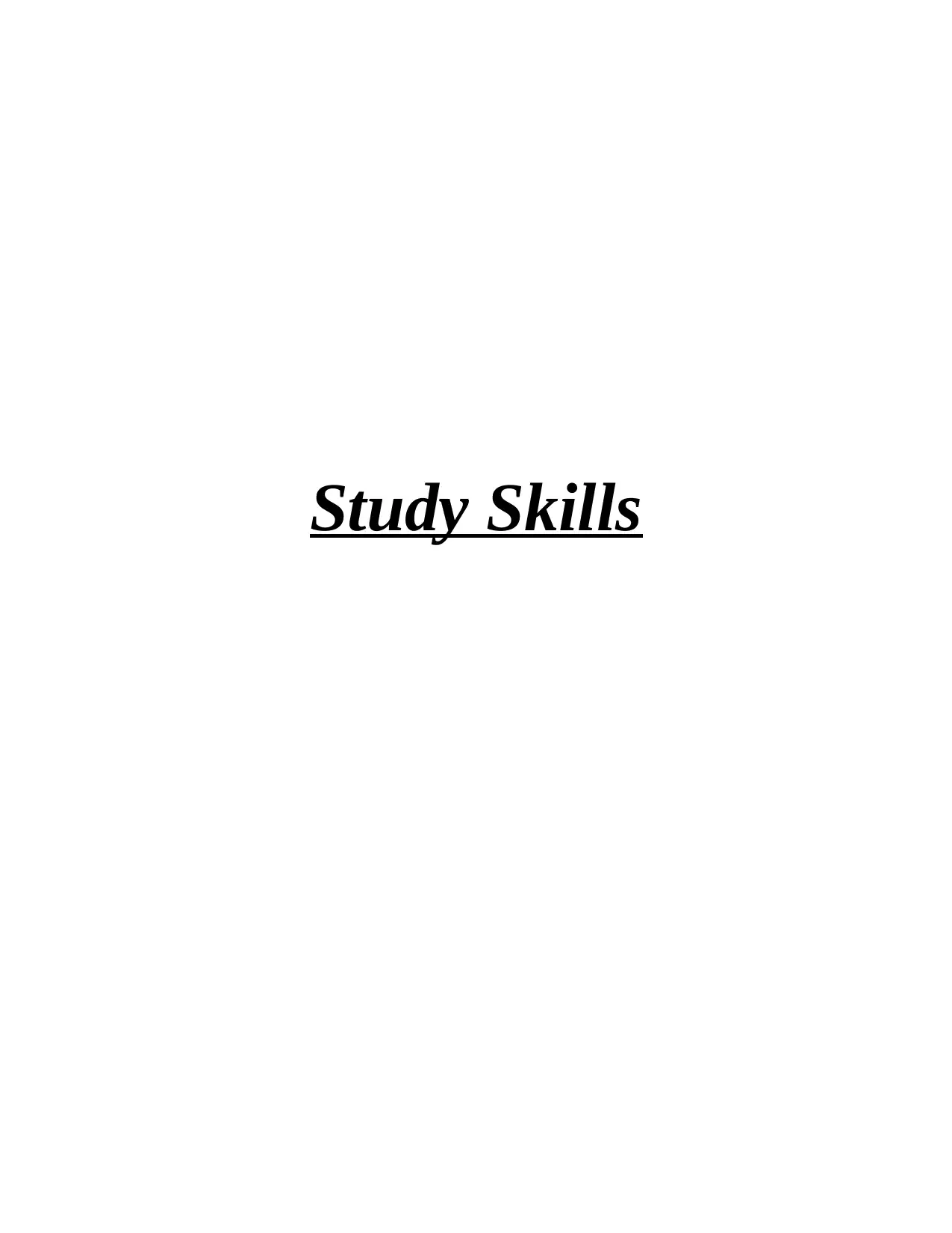
Study Skills
Paraphrase This Document
Need a fresh take? Get an instant paraphrase of this document with our AI Paraphraser
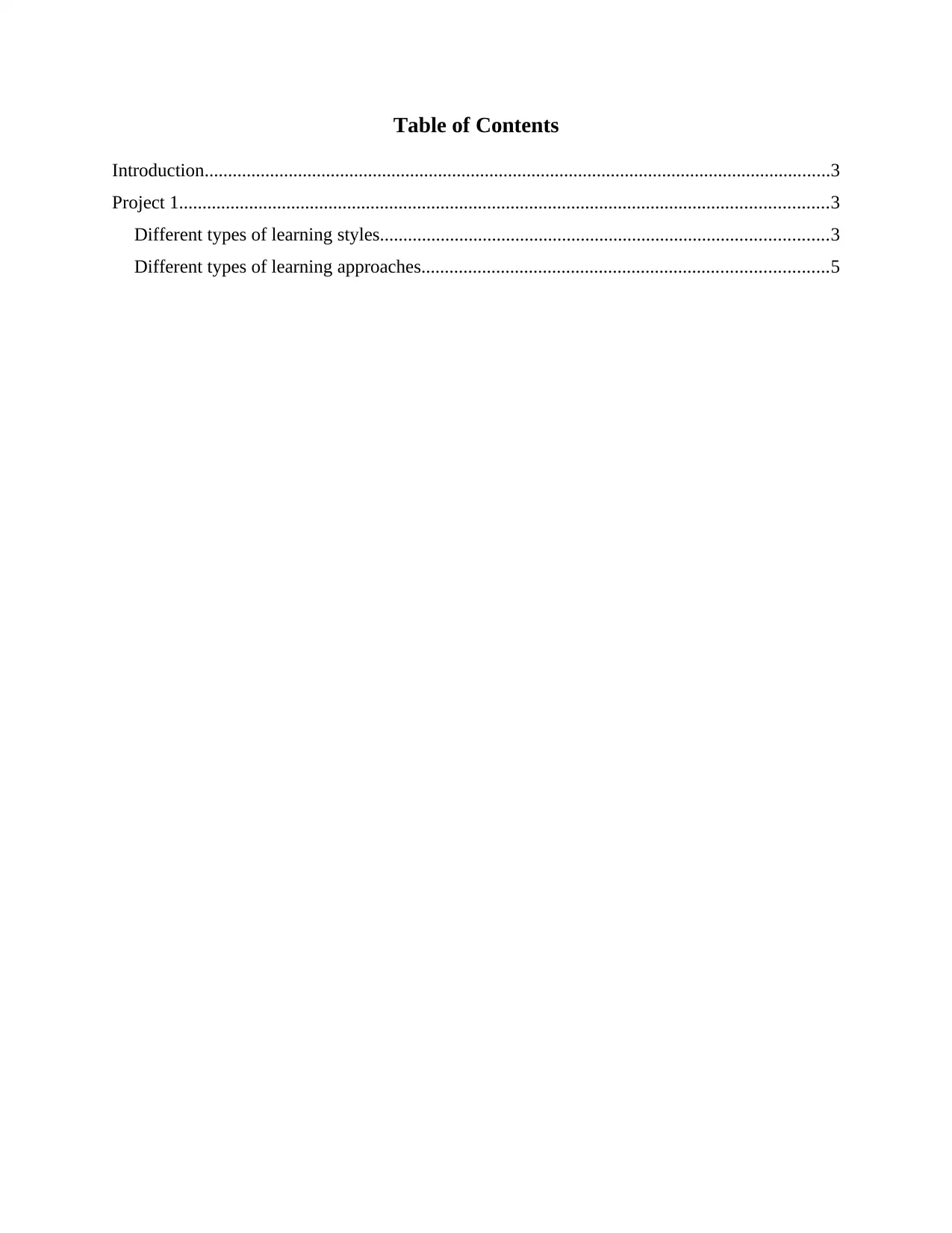
Table of Contents
Introduction......................................................................................................................................3
Project 1...........................................................................................................................................3
Different types of learning styles................................................................................................3
Different types of learning approaches.......................................................................................5
Introduction......................................................................................................................................3
Project 1...........................................................................................................................................3
Different types of learning styles................................................................................................3
Different types of learning approaches.......................................................................................5
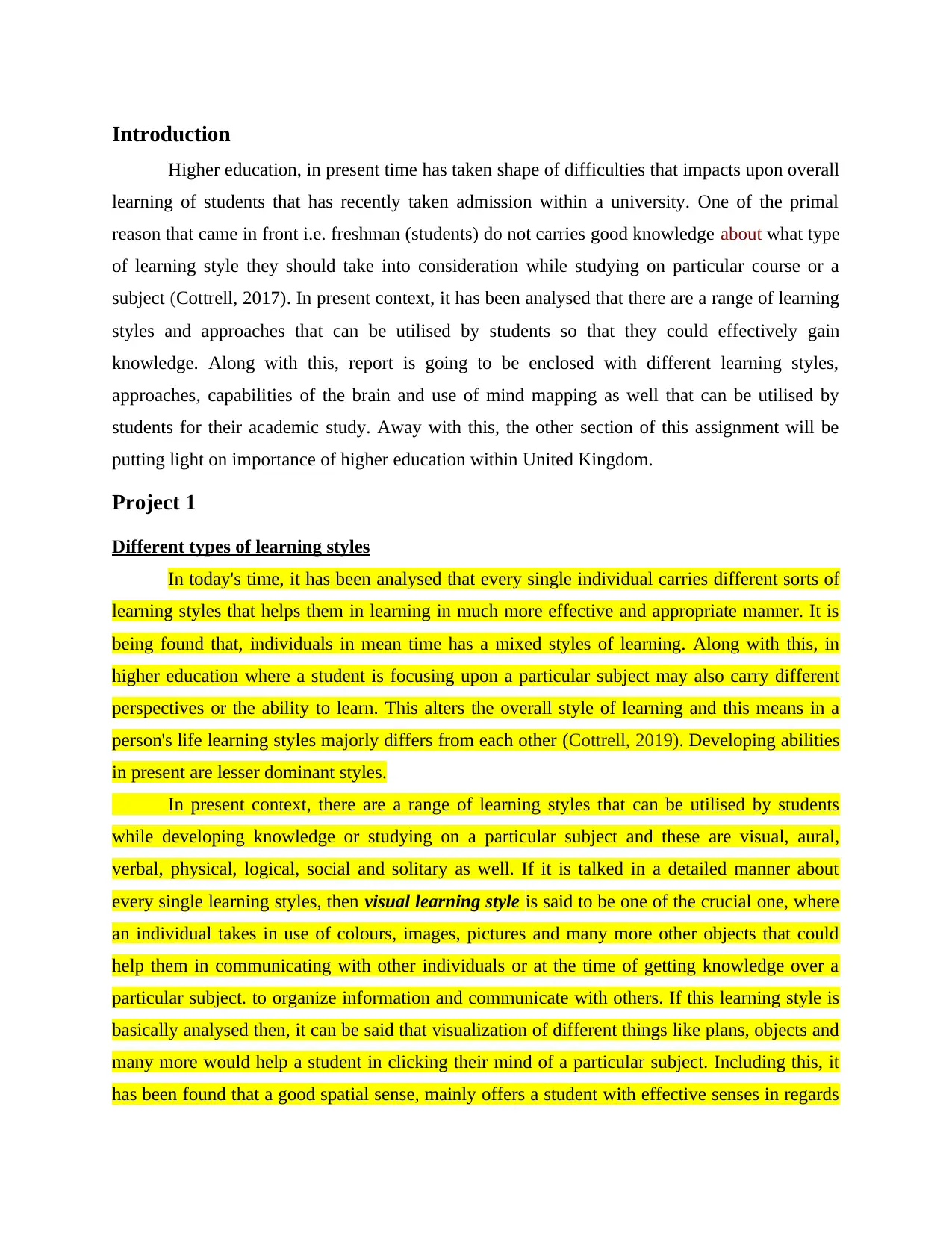
Introduction
Higher education, in present time has taken shape of difficulties that impacts upon overall
learning of students that has recently taken admission within a university. One of the primal
reason that came in front i.e. freshman (students) do not carries good knowledge about what type
of learning style they should take into consideration while studying on particular course or a
subject (Cottrell, 2017). In present context, it has been analysed that there are a range of learning
styles and approaches that can be utilised by students so that they could effectively gain
knowledge. Along with this, report is going to be enclosed with different learning styles,
approaches, capabilities of the brain and use of mind mapping as well that can be utilised by
students for their academic study. Away with this, the other section of this assignment will be
putting light on importance of higher education within United Kingdom.
Project 1
Different types of learning styles
In today's time, it has been analysed that every single individual carries different sorts of
learning styles that helps them in learning in much more effective and appropriate manner. It is
being found that, individuals in mean time has a mixed styles of learning. Along with this, in
higher education where a student is focusing upon a particular subject may also carry different
perspectives or the ability to learn. This alters the overall style of learning and this means in a
person's life learning styles majorly differs from each other (Cottrell, 2019). Developing abilities
in present are lesser dominant styles.
In present context, there are a range of learning styles that can be utilised by students
while developing knowledge or studying on a particular subject and these are visual, aural,
verbal, physical, logical, social and solitary as well. If it is talked in a detailed manner about
every single learning styles, then visual learning style is said to be one of the crucial one, where
an individual takes in use of colours, images, pictures and many more other objects that could
help them in communicating with other individuals or at the time of getting knowledge over a
particular subject. to organize information and communicate with others. If this learning style is
basically analysed then, it can be said that visualization of different things like plans, objects and
many more would help a student in clicking their mind of a particular subject. Including this, it
has been found that a good spatial sense, mainly offers a student with effective senses in regards
Higher education, in present time has taken shape of difficulties that impacts upon overall
learning of students that has recently taken admission within a university. One of the primal
reason that came in front i.e. freshman (students) do not carries good knowledge about what type
of learning style they should take into consideration while studying on particular course or a
subject (Cottrell, 2017). In present context, it has been analysed that there are a range of learning
styles and approaches that can be utilised by students so that they could effectively gain
knowledge. Along with this, report is going to be enclosed with different learning styles,
approaches, capabilities of the brain and use of mind mapping as well that can be utilised by
students for their academic study. Away with this, the other section of this assignment will be
putting light on importance of higher education within United Kingdom.
Project 1
Different types of learning styles
In today's time, it has been analysed that every single individual carries different sorts of
learning styles that helps them in learning in much more effective and appropriate manner. It is
being found that, individuals in mean time has a mixed styles of learning. Along with this, in
higher education where a student is focusing upon a particular subject may also carry different
perspectives or the ability to learn. This alters the overall style of learning and this means in a
person's life learning styles majorly differs from each other (Cottrell, 2019). Developing abilities
in present are lesser dominant styles.
In present context, there are a range of learning styles that can be utilised by students
while developing knowledge or studying on a particular subject and these are visual, aural,
verbal, physical, logical, social and solitary as well. If it is talked in a detailed manner about
every single learning styles, then visual learning style is said to be one of the crucial one, where
an individual takes in use of colours, images, pictures and many more other objects that could
help them in communicating with other individuals or at the time of getting knowledge over a
particular subject. to organize information and communicate with others. If this learning style is
basically analysed then, it can be said that visualization of different things like plans, objects and
many more would help a student in clicking their mind of a particular subject. Including this, it
has been found that a good spatial sense, mainly offers a student with effective senses in regards
⊘ This is a preview!⊘
Do you want full access?
Subscribe today to unlock all pages.

Trusted by 1+ million students worldwide
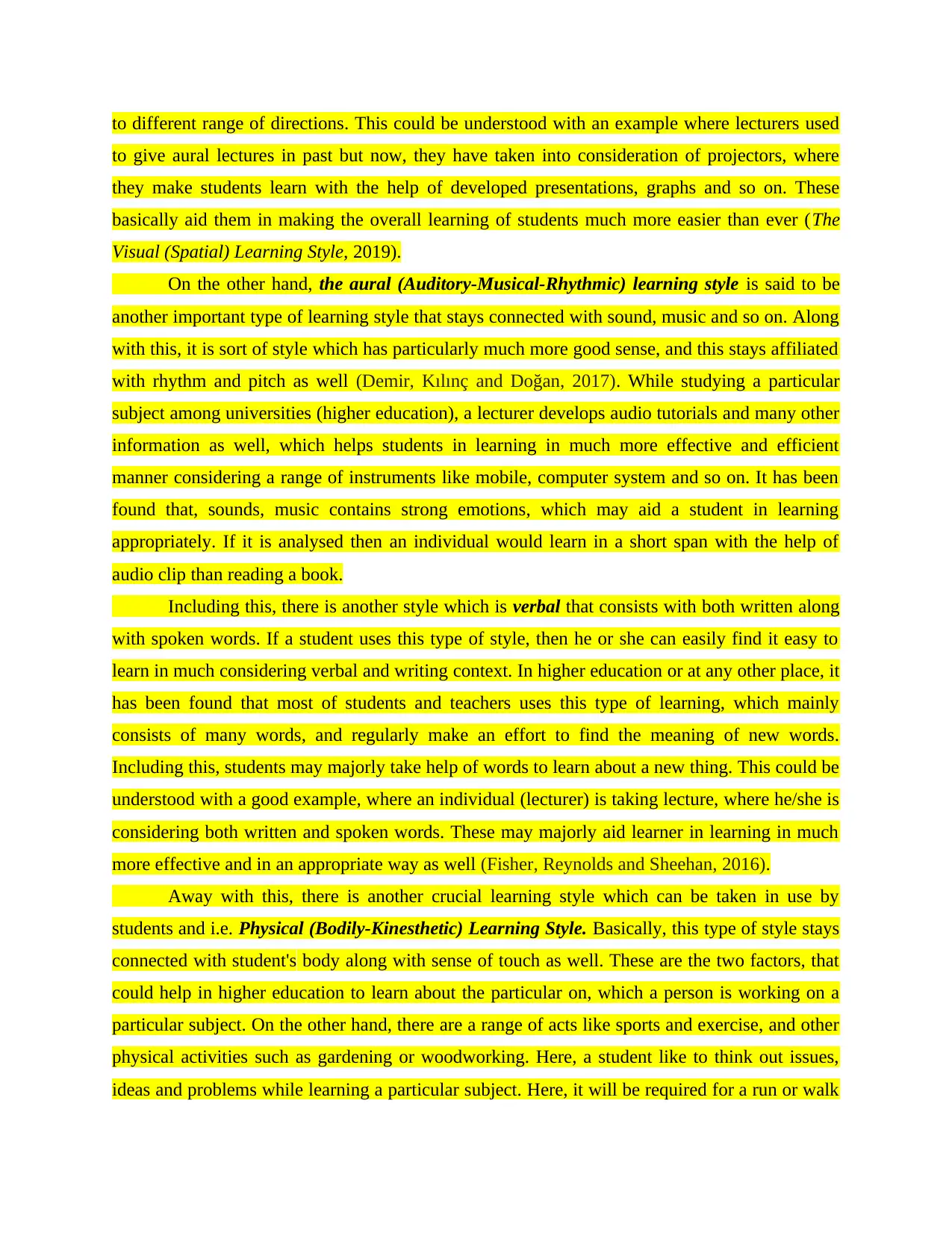
to different range of directions. This could be understood with an example where lecturers used
to give aural lectures in past but now, they have taken into consideration of projectors, where
they make students learn with the help of developed presentations, graphs and so on. These
basically aid them in making the overall learning of students much more easier than ever (The
Visual (Spatial) Learning Style, 2019).
On the other hand, the aural (Auditory-Musical-Rhythmic) learning style is said to be
another important type of learning style that stays connected with sound, music and so on. Along
with this, it is sort of style which has particularly much more good sense, and this stays affiliated
with rhythm and pitch as well (Demir, Kılınç and Doğan, 2017). While studying a particular
subject among universities (higher education), a lecturer develops audio tutorials and many other
information as well, which helps students in learning in much more effective and efficient
manner considering a range of instruments like mobile, computer system and so on. It has been
found that, sounds, music contains strong emotions, which may aid a student in learning
appropriately. If it is analysed then an individual would learn in a short span with the help of
audio clip than reading a book.
Including this, there is another style which is verbal that consists with both written along
with spoken words. If a student uses this type of style, then he or she can easily find it easy to
learn in much considering verbal and writing context. In higher education or at any other place, it
has been found that most of students and teachers uses this type of learning, which mainly
consists of many words, and regularly make an effort to find the meaning of new words.
Including this, students may majorly take help of words to learn about a new thing. This could be
understood with a good example, where an individual (lecturer) is taking lecture, where he/she is
considering both written and spoken words. These may majorly aid learner in learning in much
more effective and in an appropriate way as well (Fisher, Reynolds and Sheehan, 2016).
Away with this, there is another crucial learning style which can be taken in use by
students and i.e. Physical (Bodily-Kinesthetic) Learning Style. Basically, this type of style stays
connected with student's body along with sense of touch as well. These are the two factors, that
could help in higher education to learn about the particular on, which a person is working on a
particular subject. On the other hand, there are a range of acts like sports and exercise, and other
physical activities such as gardening or woodworking. Here, a student like to think out issues,
ideas and problems while learning a particular subject. Here, it will be required for a run or walk
to give aural lectures in past but now, they have taken into consideration of projectors, where
they make students learn with the help of developed presentations, graphs and so on. These
basically aid them in making the overall learning of students much more easier than ever (The
Visual (Spatial) Learning Style, 2019).
On the other hand, the aural (Auditory-Musical-Rhythmic) learning style is said to be
another important type of learning style that stays connected with sound, music and so on. Along
with this, it is sort of style which has particularly much more good sense, and this stays affiliated
with rhythm and pitch as well (Demir, Kılınç and Doğan, 2017). While studying a particular
subject among universities (higher education), a lecturer develops audio tutorials and many other
information as well, which helps students in learning in much more effective and efficient
manner considering a range of instruments like mobile, computer system and so on. It has been
found that, sounds, music contains strong emotions, which may aid a student in learning
appropriately. If it is analysed then an individual would learn in a short span with the help of
audio clip than reading a book.
Including this, there is another style which is verbal that consists with both written along
with spoken words. If a student uses this type of style, then he or she can easily find it easy to
learn in much considering verbal and writing context. In higher education or at any other place, it
has been found that most of students and teachers uses this type of learning, which mainly
consists of many words, and regularly make an effort to find the meaning of new words.
Including this, students may majorly take help of words to learn about a new thing. This could be
understood with a good example, where an individual (lecturer) is taking lecture, where he/she is
considering both written and spoken words. These may majorly aid learner in learning in much
more effective and in an appropriate way as well (Fisher, Reynolds and Sheehan, 2016).
Away with this, there is another crucial learning style which can be taken in use by
students and i.e. Physical (Bodily-Kinesthetic) Learning Style. Basically, this type of style stays
connected with student's body along with sense of touch as well. These are the two factors, that
could help in higher education to learn about the particular on, which a person is working on a
particular subject. On the other hand, there are a range of acts like sports and exercise, and other
physical activities such as gardening or woodworking. Here, a student like to think out issues,
ideas and problems while learning a particular subject. Here, it will be required for a run or walk
Paraphrase This Document
Need a fresh take? Get an instant paraphrase of this document with our AI Paraphraser
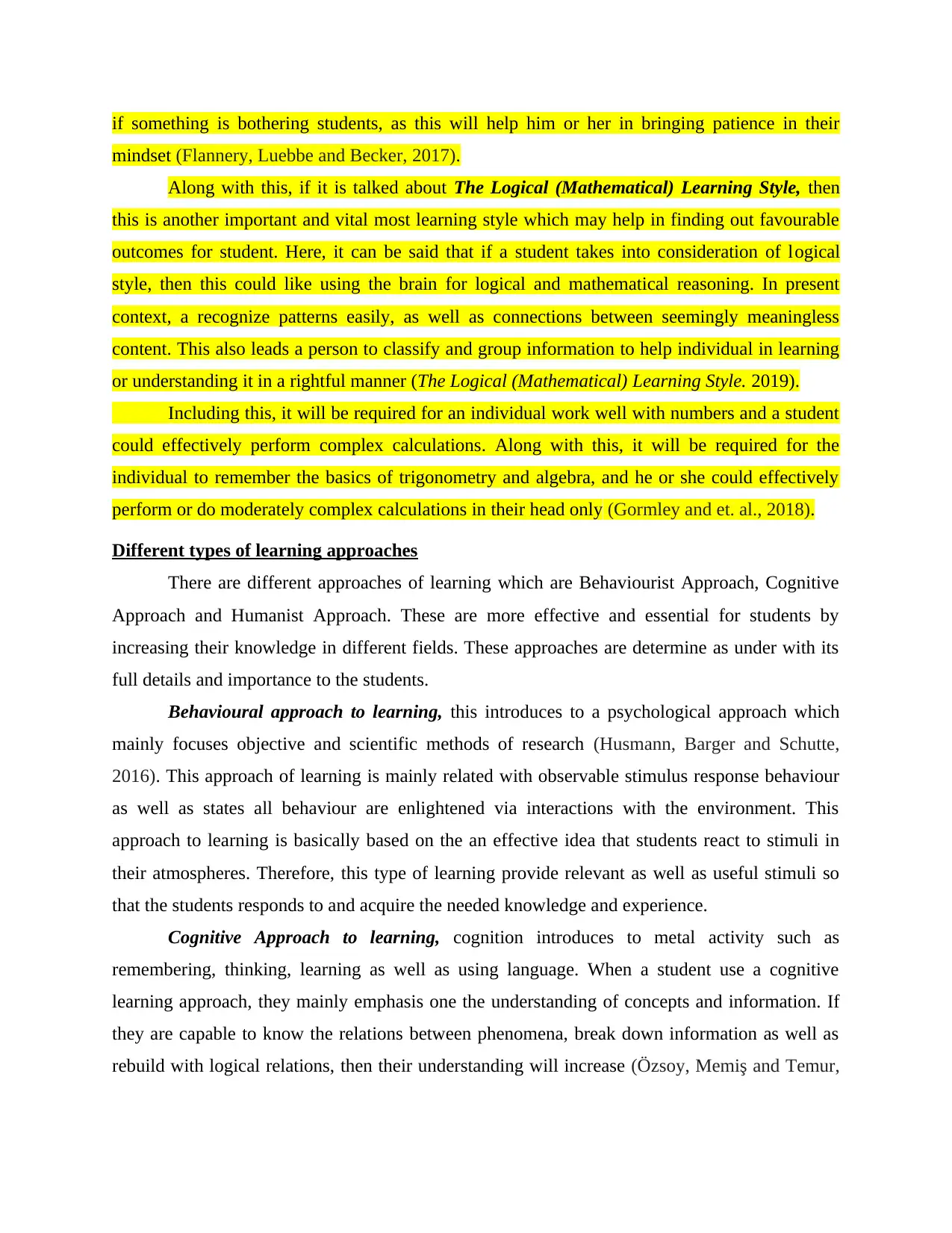
if something is bothering students, as this will help him or her in bringing patience in their
mindset (Flannery, Luebbe and Becker, 2017).
Along with this, if it is talked about The Logical (Mathematical) Learning Style, then
this is another important and vital most learning style which may help in finding out favourable
outcomes for student. Here, it can be said that if a student takes into consideration of logical
style, then this could like using the brain for logical and mathematical reasoning. In present
context, a recognize patterns easily, as well as connections between seemingly meaningless
content. This also leads a person to classify and group information to help individual in learning
or understanding it in a rightful manner (The Logical (Mathematical) Learning Style. 2019).
Including this, it will be required for an individual work well with numbers and a student
could effectively perform complex calculations. Along with this, it will be required for the
individual to remember the basics of trigonometry and algebra, and he or she could effectively
perform or do moderately complex calculations in their head only (Gormley and et. al., 2018).
Different types of learning approaches
There are different approaches of learning which are Behaviourist Approach, Cognitive
Approach and Humanist Approach. These are more effective and essential for students by
increasing their knowledge in different fields. These approaches are determine as under with its
full details and importance to the students.
Behavioural approach to learning, this introduces to a psychological approach which
mainly focuses objective and scientific methods of research (Husmann, Barger and Schutte,
2016). This approach of learning is mainly related with observable stimulus response behaviour
as well as states all behaviour are enlightened via interactions with the environment. This
approach to learning is basically based on the an effective idea that students react to stimuli in
their atmospheres. Therefore, this type of learning provide relevant as well as useful stimuli so
that the students responds to and acquire the needed knowledge and experience.
Cognitive Approach to learning, cognition introduces to metal activity such as
remembering, thinking, learning as well as using language. When a student use a cognitive
learning approach, they mainly emphasis one the understanding of concepts and information. If
they are capable to know the relations between phenomena, break down information as well as
rebuild with logical relations, then their understanding will increase (Özsoy, Memiş and Temur,
mindset (Flannery, Luebbe and Becker, 2017).
Along with this, if it is talked about The Logical (Mathematical) Learning Style, then
this is another important and vital most learning style which may help in finding out favourable
outcomes for student. Here, it can be said that if a student takes into consideration of logical
style, then this could like using the brain for logical and mathematical reasoning. In present
context, a recognize patterns easily, as well as connections between seemingly meaningless
content. This also leads a person to classify and group information to help individual in learning
or understanding it in a rightful manner (The Logical (Mathematical) Learning Style. 2019).
Including this, it will be required for an individual work well with numbers and a student
could effectively perform complex calculations. Along with this, it will be required for the
individual to remember the basics of trigonometry and algebra, and he or she could effectively
perform or do moderately complex calculations in their head only (Gormley and et. al., 2018).
Different types of learning approaches
There are different approaches of learning which are Behaviourist Approach, Cognitive
Approach and Humanist Approach. These are more effective and essential for students by
increasing their knowledge in different fields. These approaches are determine as under with its
full details and importance to the students.
Behavioural approach to learning, this introduces to a psychological approach which
mainly focuses objective and scientific methods of research (Husmann, Barger and Schutte,
2016). This approach of learning is mainly related with observable stimulus response behaviour
as well as states all behaviour are enlightened via interactions with the environment. This
approach to learning is basically based on the an effective idea that students react to stimuli in
their atmospheres. Therefore, this type of learning provide relevant as well as useful stimuli so
that the students responds to and acquire the needed knowledge and experience.
Cognitive Approach to learning, cognition introduces to metal activity such as
remembering, thinking, learning as well as using language. When a student use a cognitive
learning approach, they mainly emphasis one the understanding of concepts and information. If
they are capable to know the relations between phenomena, break down information as well as
rebuild with logical relations, then their understanding will increase (Özsoy, Memiş and Temur,
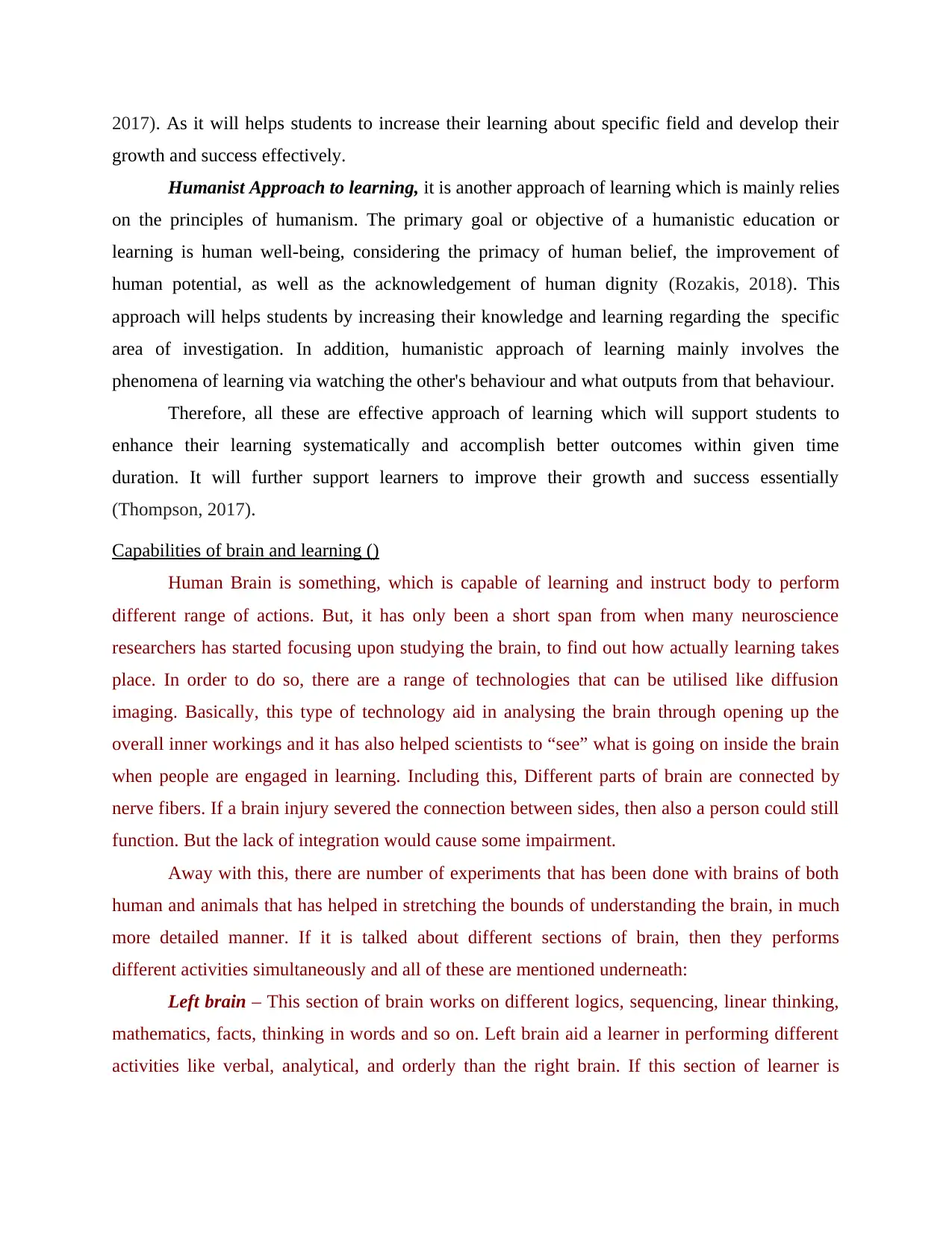
2017). As it will helps students to increase their learning about specific field and develop their
growth and success effectively.
Humanist Approach to learning, it is another approach of learning which is mainly relies
on the principles of humanism. The primary goal or objective of a humanistic education or
learning is human well-being, considering the primacy of human belief, the improvement of
human potential, as well as the acknowledgement of human dignity (Rozakis, 2018). This
approach will helps students by increasing their knowledge and learning regarding the specific
area of investigation. In addition, humanistic approach of learning mainly involves the
phenomena of learning via watching the other's behaviour and what outputs from that behaviour.
Therefore, all these are effective approach of learning which will support students to
enhance their learning systematically and accomplish better outcomes within given time
duration. It will further support learners to improve their growth and success essentially
(Thompson, 2017).
Capabilities of brain and learning ()
Human Brain is something, which is capable of learning and instruct body to perform
different range of actions. But, it has only been a short span from when many neuroscience
researchers has started focusing upon studying the brain, to find out how actually learning takes
place. In order to do so, there are a range of technologies that can be utilised like diffusion
imaging. Basically, this type of technology aid in analysing the brain through opening up the
overall inner workings and it has also helped scientists to “see” what is going on inside the brain
when people are engaged in learning. Including this, Different parts of brain are connected by
nerve fibers. If a brain injury severed the connection between sides, then also a person could still
function. But the lack of integration would cause some impairment.
Away with this, there are number of experiments that has been done with brains of both
human and animals that has helped in stretching the bounds of understanding the brain, in much
more detailed manner. If it is talked about different sections of brain, then they performs
different activities simultaneously and all of these are mentioned underneath:
Left brain – This section of brain works on different logics, sequencing, linear thinking,
mathematics, facts, thinking in words and so on. Left brain aid a learner in performing different
activities like verbal, analytical, and orderly than the right brain. If this section of learner is
growth and success effectively.
Humanist Approach to learning, it is another approach of learning which is mainly relies
on the principles of humanism. The primary goal or objective of a humanistic education or
learning is human well-being, considering the primacy of human belief, the improvement of
human potential, as well as the acknowledgement of human dignity (Rozakis, 2018). This
approach will helps students by increasing their knowledge and learning regarding the specific
area of investigation. In addition, humanistic approach of learning mainly involves the
phenomena of learning via watching the other's behaviour and what outputs from that behaviour.
Therefore, all these are effective approach of learning which will support students to
enhance their learning systematically and accomplish better outcomes within given time
duration. It will further support learners to improve their growth and success essentially
(Thompson, 2017).
Capabilities of brain and learning ()
Human Brain is something, which is capable of learning and instruct body to perform
different range of actions. But, it has only been a short span from when many neuroscience
researchers has started focusing upon studying the brain, to find out how actually learning takes
place. In order to do so, there are a range of technologies that can be utilised like diffusion
imaging. Basically, this type of technology aid in analysing the brain through opening up the
overall inner workings and it has also helped scientists to “see” what is going on inside the brain
when people are engaged in learning. Including this, Different parts of brain are connected by
nerve fibers. If a brain injury severed the connection between sides, then also a person could still
function. But the lack of integration would cause some impairment.
Away with this, there are number of experiments that has been done with brains of both
human and animals that has helped in stretching the bounds of understanding the brain, in much
more detailed manner. If it is talked about different sections of brain, then they performs
different activities simultaneously and all of these are mentioned underneath:
Left brain – This section of brain works on different logics, sequencing, linear thinking,
mathematics, facts, thinking in words and so on. Left brain aid a learner in performing different
activities like verbal, analytical, and orderly than the right brain. If this section of learner is
⊘ This is a preview!⊘
Do you want full access?
Subscribe today to unlock all pages.

Trusted by 1+ million students worldwide
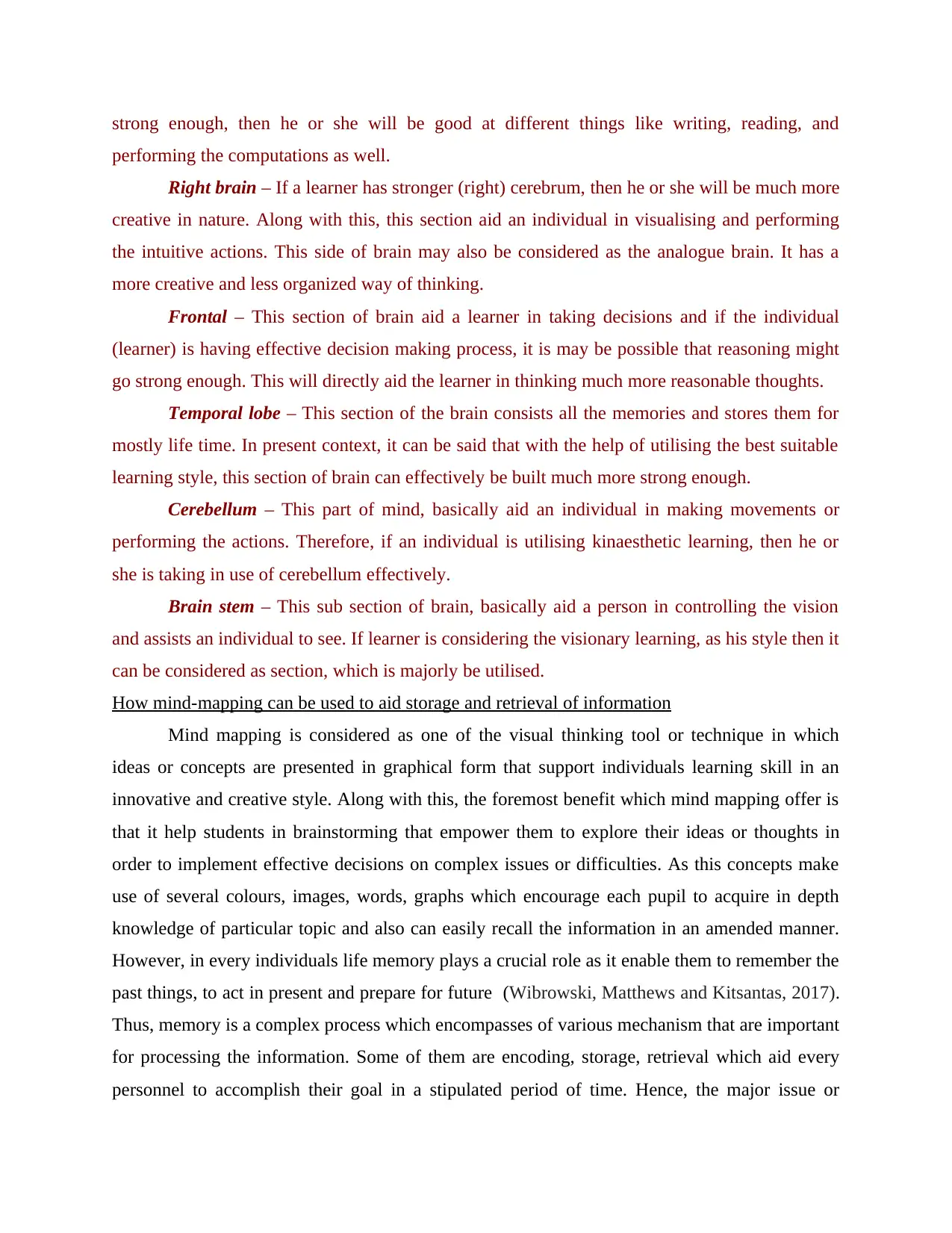
strong enough, then he or she will be good at different things like writing, reading, and
performing the computations as well.
Right brain – If a learner has stronger (right) cerebrum, then he or she will be much more
creative in nature. Along with this, this section aid an individual in visualising and performing
the intuitive actions. This side of brain may also be considered as the analogue brain. It has a
more creative and less organized way of thinking.
Frontal – This section of brain aid a learner in taking decisions and if the individual
(learner) is having effective decision making process, it is may be possible that reasoning might
go strong enough. This will directly aid the learner in thinking much more reasonable thoughts.
Temporal lobe – This section of the brain consists all the memories and stores them for
mostly life time. In present context, it can be said that with the help of utilising the best suitable
learning style, this section of brain can effectively be built much more strong enough.
Cerebellum – This part of mind, basically aid an individual in making movements or
performing the actions. Therefore, if an individual is utilising kinaesthetic learning, then he or
she is taking in use of cerebellum effectively.
Brain stem – This sub section of brain, basically aid a person in controlling the vision
and assists an individual to see. If learner is considering the visionary learning, as his style then it
can be considered as section, which is majorly be utilised.
How mind-mapping can be used to aid storage and retrieval of information
Mind mapping is considered as one of the visual thinking tool or technique in which
ideas or concepts are presented in graphical form that support individuals learning skill in an
innovative and creative style. Along with this, the foremost benefit which mind mapping offer is
that it help students in brainstorming that empower them to explore their ideas or thoughts in
order to implement effective decisions on complex issues or difficulties. As this concepts make
use of several colours, images, words, graphs which encourage each pupil to acquire in depth
knowledge of particular topic and also can easily recall the information in an amended manner.
However, in every individuals life memory plays a crucial role as it enable them to remember the
past things, to act in present and prepare for future (Wibrowski, Matthews and Kitsantas, 2017).
Thus, memory is a complex process which encompasses of various mechanism that are important
for processing the information. Some of them are encoding, storage, retrieval which aid every
personnel to accomplish their goal in a stipulated period of time. Hence, the major issue or
performing the computations as well.
Right brain – If a learner has stronger (right) cerebrum, then he or she will be much more
creative in nature. Along with this, this section aid an individual in visualising and performing
the intuitive actions. This side of brain may also be considered as the analogue brain. It has a
more creative and less organized way of thinking.
Frontal – This section of brain aid a learner in taking decisions and if the individual
(learner) is having effective decision making process, it is may be possible that reasoning might
go strong enough. This will directly aid the learner in thinking much more reasonable thoughts.
Temporal lobe – This section of the brain consists all the memories and stores them for
mostly life time. In present context, it can be said that with the help of utilising the best suitable
learning style, this section of brain can effectively be built much more strong enough.
Cerebellum – This part of mind, basically aid an individual in making movements or
performing the actions. Therefore, if an individual is utilising kinaesthetic learning, then he or
she is taking in use of cerebellum effectively.
Brain stem – This sub section of brain, basically aid a person in controlling the vision
and assists an individual to see. If learner is considering the visionary learning, as his style then it
can be considered as section, which is majorly be utilised.
How mind-mapping can be used to aid storage and retrieval of information
Mind mapping is considered as one of the visual thinking tool or technique in which
ideas or concepts are presented in graphical form that support individuals learning skill in an
innovative and creative style. Along with this, the foremost benefit which mind mapping offer is
that it help students in brainstorming that empower them to explore their ideas or thoughts in
order to implement effective decisions on complex issues or difficulties. As this concepts make
use of several colours, images, words, graphs which encourage each pupil to acquire in depth
knowledge of particular topic and also can easily recall the information in an amended manner.
However, in every individuals life memory plays a crucial role as it enable them to remember the
past things, to act in present and prepare for future (Wibrowski, Matthews and Kitsantas, 2017).
Thus, memory is a complex process which encompasses of various mechanism that are important
for processing the information. Some of them are encoding, storage, retrieval which aid every
personnel to accomplish their goal in a stipulated period of time. Hence, the major issue or
Paraphrase This Document
Need a fresh take? Get an instant paraphrase of this document with our AI Paraphraser
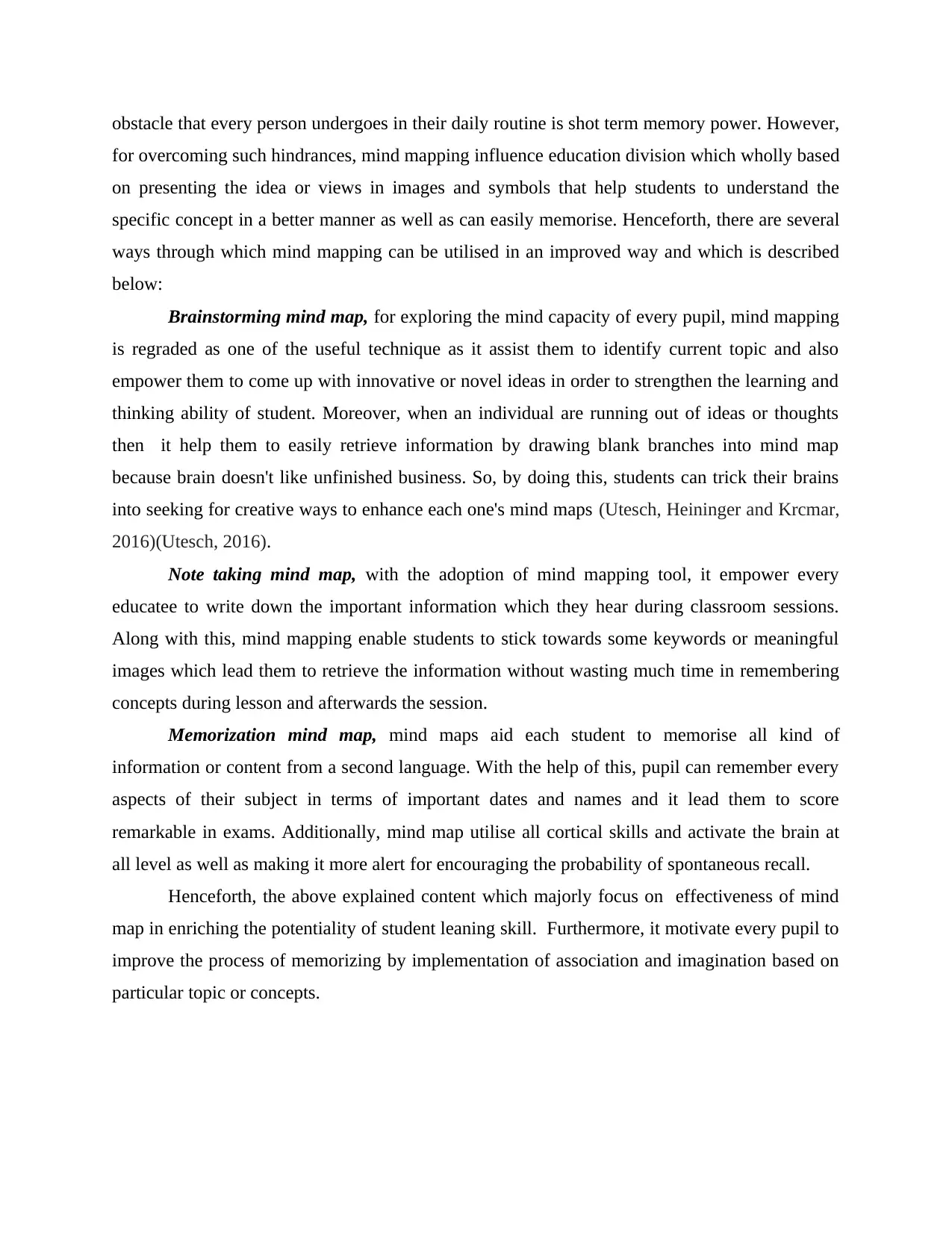
obstacle that every person undergoes in their daily routine is shot term memory power. However,
for overcoming such hindrances, mind mapping influence education division which wholly based
on presenting the idea or views in images and symbols that help students to understand the
specific concept in a better manner as well as can easily memorise. Henceforth, there are several
ways through which mind mapping can be utilised in an improved way and which is described
below:
Brainstorming mind map, for exploring the mind capacity of every pupil, mind mapping
is regraded as one of the useful technique as it assist them to identify current topic and also
empower them to come up with innovative or novel ideas in order to strengthen the learning and
thinking ability of student. Moreover, when an individual are running out of ideas or thoughts
then it help them to easily retrieve information by drawing blank branches into mind map
because brain doesn't like unfinished business. So, by doing this, students can trick their brains
into seeking for creative ways to enhance each one's mind maps (Utesch, Heininger and Krcmar,
2016)(Utesch, 2016).
Note taking mind map, with the adoption of mind mapping tool, it empower every
educatee to write down the important information which they hear during classroom sessions.
Along with this, mind mapping enable students to stick towards some keywords or meaningful
images which lead them to retrieve the information without wasting much time in remembering
concepts during lesson and afterwards the session.
Memorization mind map, mind maps aid each student to memorise all kind of
information or content from a second language. With the help of this, pupil can remember every
aspects of their subject in terms of important dates and names and it lead them to score
remarkable in exams. Additionally, mind map utilise all cortical skills and activate the brain at
all level as well as making it more alert for encouraging the probability of spontaneous recall.
Henceforth, the above explained content which majorly focus on effectiveness of mind
map in enriching the potentiality of student leaning skill. Furthermore, it motivate every pupil to
improve the process of memorizing by implementation of association and imagination based on
particular topic or concepts.
for overcoming such hindrances, mind mapping influence education division which wholly based
on presenting the idea or views in images and symbols that help students to understand the
specific concept in a better manner as well as can easily memorise. Henceforth, there are several
ways through which mind mapping can be utilised in an improved way and which is described
below:
Brainstorming mind map, for exploring the mind capacity of every pupil, mind mapping
is regraded as one of the useful technique as it assist them to identify current topic and also
empower them to come up with innovative or novel ideas in order to strengthen the learning and
thinking ability of student. Moreover, when an individual are running out of ideas or thoughts
then it help them to easily retrieve information by drawing blank branches into mind map
because brain doesn't like unfinished business. So, by doing this, students can trick their brains
into seeking for creative ways to enhance each one's mind maps (Utesch, Heininger and Krcmar,
2016)(Utesch, 2016).
Note taking mind map, with the adoption of mind mapping tool, it empower every
educatee to write down the important information which they hear during classroom sessions.
Along with this, mind mapping enable students to stick towards some keywords or meaningful
images which lead them to retrieve the information without wasting much time in remembering
concepts during lesson and afterwards the session.
Memorization mind map, mind maps aid each student to memorise all kind of
information or content from a second language. With the help of this, pupil can remember every
aspects of their subject in terms of important dates and names and it lead them to score
remarkable in exams. Additionally, mind map utilise all cortical skills and activate the brain at
all level as well as making it more alert for encouraging the probability of spontaneous recall.
Henceforth, the above explained content which majorly focus on effectiveness of mind
map in enriching the potentiality of student leaning skill. Furthermore, it motivate every pupil to
improve the process of memorizing by implementation of association and imagination based on
particular topic or concepts.
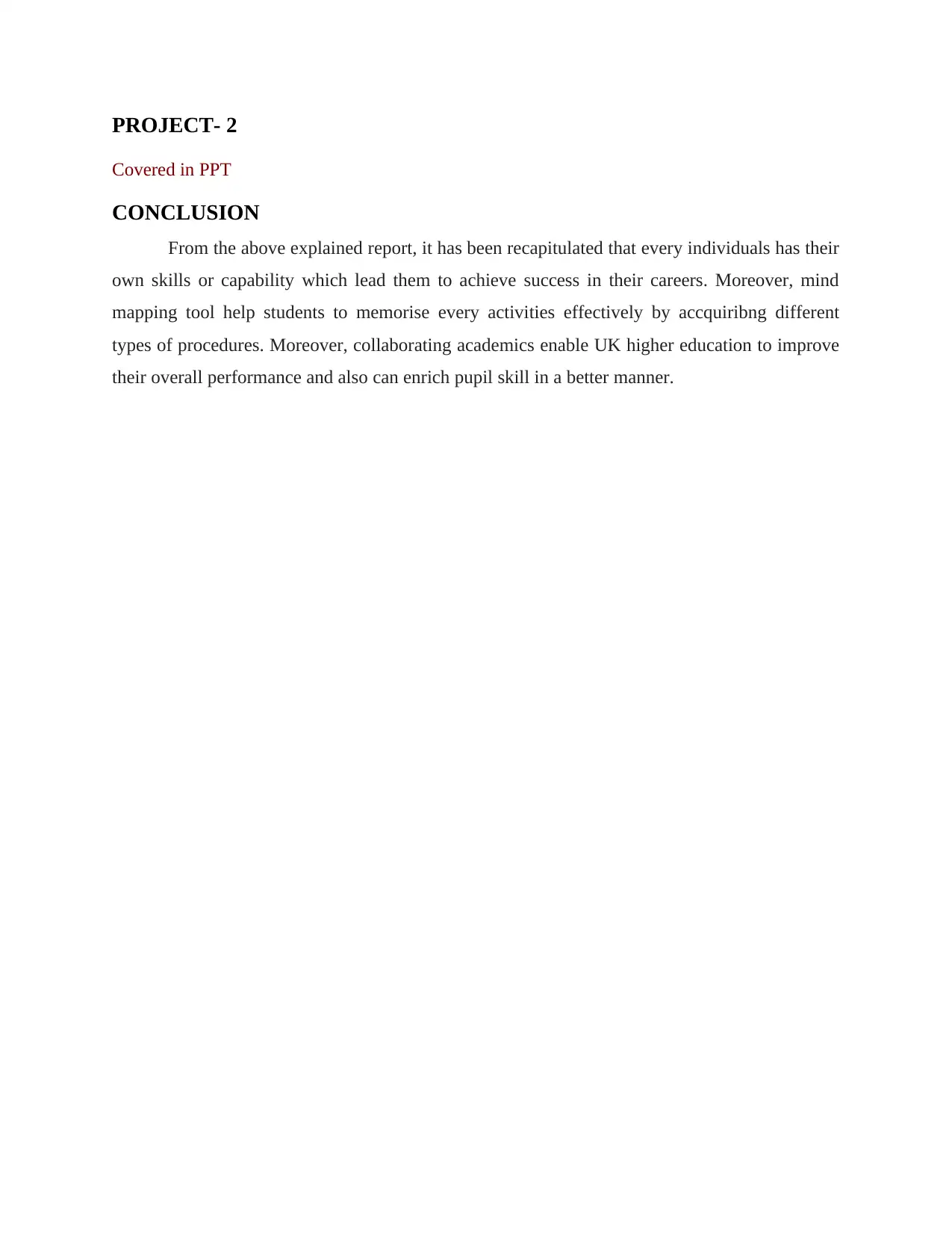
PROJECT- 2
Covered in PPT
CONCLUSION
From the above explained report, it has been recapitulated that every individuals has their
own skills or capability which lead them to achieve success in their careers. Moreover, mind
mapping tool help students to memorise every activities effectively by accquiribng different
types of procedures. Moreover, collaborating academics enable UK higher education to improve
their overall performance and also can enrich pupil skill in a better manner.
Covered in PPT
CONCLUSION
From the above explained report, it has been recapitulated that every individuals has their
own skills or capability which lead them to achieve success in their careers. Moreover, mind
mapping tool help students to memorise every activities effectively by accquiribng different
types of procedures. Moreover, collaborating academics enable UK higher education to improve
their overall performance and also can enrich pupil skill in a better manner.
⊘ This is a preview!⊘
Do you want full access?
Subscribe today to unlock all pages.

Trusted by 1+ million students worldwide
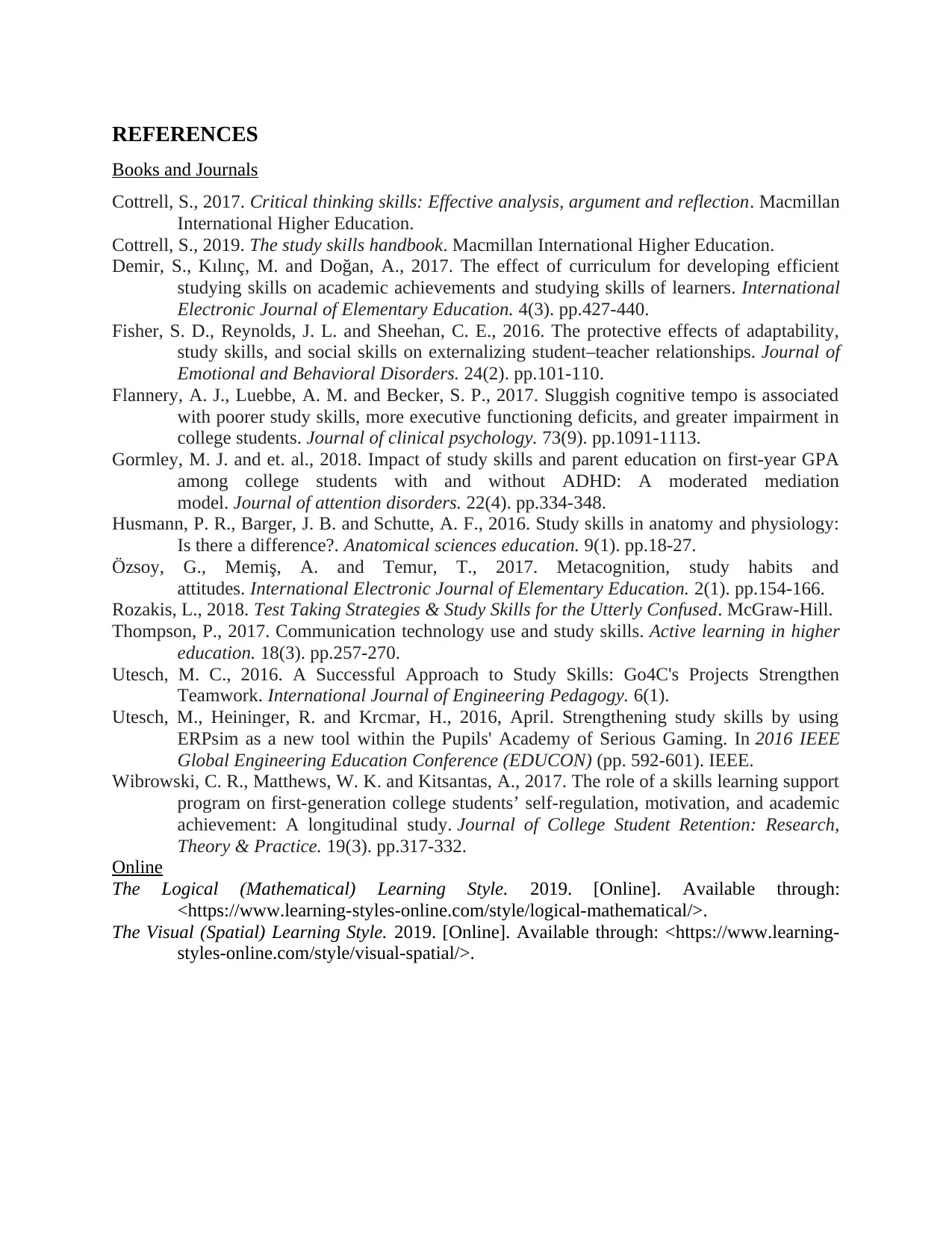
REFERENCES
Books and Journals
Cottrell, S., 2017. Critical thinking skills: Effective analysis, argument and reflection. Macmillan
International Higher Education.
Cottrell, S., 2019. The study skills handbook. Macmillan International Higher Education.
Demir, S., Kılınç, M. and Doğan, A., 2017. The effect of curriculum for developing efficient
studying skills on academic achievements and studying skills of learners. International
Electronic Journal of Elementary Education. 4(3). pp.427-440.
Fisher, S. D., Reynolds, J. L. and Sheehan, C. E., 2016. The protective effects of adaptability,
study skills, and social skills on externalizing student–teacher relationships. Journal of
Emotional and Behavioral Disorders. 24(2). pp.101-110.
Flannery, A. J., Luebbe, A. M. and Becker, S. P., 2017. Sluggish cognitive tempo is associated
with poorer study skills, more executive functioning deficits, and greater impairment in
college students. Journal of clinical psychology. 73(9). pp.1091-1113.
Gormley, M. J. and et. al., 2018. Impact of study skills and parent education on first-year GPA
among college students with and without ADHD: A moderated mediation
model. Journal of attention disorders. 22(4). pp.334-348.
Husmann, P. R., Barger, J. B. and Schutte, A. F., 2016. Study skills in anatomy and physiology:
Is there a difference?. Anatomical sciences education. 9(1). pp.18-27.
Özsoy, G., Memiş, A. and Temur, T., 2017. Metacognition, study habits and
attitudes. International Electronic Journal of Elementary Education. 2(1). pp.154-166.
Rozakis, L., 2018. Test Taking Strategies & Study Skills for the Utterly Confused. McGraw-Hill.
Thompson, P., 2017. Communication technology use and study skills. Active learning in higher
education. 18(3). pp.257-270.
Utesch, M. C., 2016. A Successful Approach to Study Skills: Go4C's Projects Strengthen
Teamwork. International Journal of Engineering Pedagogy. 6(1).
Utesch, M., Heininger, R. and Krcmar, H., 2016, April. Strengthening study skills by using
ERPsim as a new tool within the Pupils' Academy of Serious Gaming. In 2016 IEEE
Global Engineering Education Conference (EDUCON) (pp. 592-601). IEEE.
Wibrowski, C. R., Matthews, W. K. and Kitsantas, A., 2017. The role of a skills learning support
program on first-generation college students’ self-regulation, motivation, and academic
achievement: A longitudinal study. Journal of College Student Retention: Research,
Theory & Practice. 19(3). pp.317-332.
Online
The Logical (Mathematical) Learning Style. 2019. [Online]. Available through:
<https://www.learning-styles-online.com/style/logical-mathematical/>.
The Visual (Spatial) Learning Style. 2019. [Online]. Available through: <https://www.learning-
styles-online.com/style/visual-spatial/>.
Books and Journals
Cottrell, S., 2017. Critical thinking skills: Effective analysis, argument and reflection. Macmillan
International Higher Education.
Cottrell, S., 2019. The study skills handbook. Macmillan International Higher Education.
Demir, S., Kılınç, M. and Doğan, A., 2017. The effect of curriculum for developing efficient
studying skills on academic achievements and studying skills of learners. International
Electronic Journal of Elementary Education. 4(3). pp.427-440.
Fisher, S. D., Reynolds, J. L. and Sheehan, C. E., 2016. The protective effects of adaptability,
study skills, and social skills on externalizing student–teacher relationships. Journal of
Emotional and Behavioral Disorders. 24(2). pp.101-110.
Flannery, A. J., Luebbe, A. M. and Becker, S. P., 2017. Sluggish cognitive tempo is associated
with poorer study skills, more executive functioning deficits, and greater impairment in
college students. Journal of clinical psychology. 73(9). pp.1091-1113.
Gormley, M. J. and et. al., 2018. Impact of study skills and parent education on first-year GPA
among college students with and without ADHD: A moderated mediation
model. Journal of attention disorders. 22(4). pp.334-348.
Husmann, P. R., Barger, J. B. and Schutte, A. F., 2016. Study skills in anatomy and physiology:
Is there a difference?. Anatomical sciences education. 9(1). pp.18-27.
Özsoy, G., Memiş, A. and Temur, T., 2017. Metacognition, study habits and
attitudes. International Electronic Journal of Elementary Education. 2(1). pp.154-166.
Rozakis, L., 2018. Test Taking Strategies & Study Skills for the Utterly Confused. McGraw-Hill.
Thompson, P., 2017. Communication technology use and study skills. Active learning in higher
education. 18(3). pp.257-270.
Utesch, M. C., 2016. A Successful Approach to Study Skills: Go4C's Projects Strengthen
Teamwork. International Journal of Engineering Pedagogy. 6(1).
Utesch, M., Heininger, R. and Krcmar, H., 2016, April. Strengthening study skills by using
ERPsim as a new tool within the Pupils' Academy of Serious Gaming. In 2016 IEEE
Global Engineering Education Conference (EDUCON) (pp. 592-601). IEEE.
Wibrowski, C. R., Matthews, W. K. and Kitsantas, A., 2017. The role of a skills learning support
program on first-generation college students’ self-regulation, motivation, and academic
achievement: A longitudinal study. Journal of College Student Retention: Research,
Theory & Practice. 19(3). pp.317-332.
Online
The Logical (Mathematical) Learning Style. 2019. [Online]. Available through:
<https://www.learning-styles-online.com/style/logical-mathematical/>.
The Visual (Spatial) Learning Style. 2019. [Online]. Available through: <https://www.learning-
styles-online.com/style/visual-spatial/>.
1 out of 10
Related Documents
Your All-in-One AI-Powered Toolkit for Academic Success.
+13062052269
info@desklib.com
Available 24*7 on WhatsApp / Email
![[object Object]](/_next/static/media/star-bottom.7253800d.svg)
Unlock your academic potential
Copyright © 2020–2025 A2Z Services. All Rights Reserved. Developed and managed by ZUCOL.



